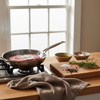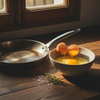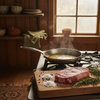Slotted Spoon for Draining & Serving Like a Pro
Key Takeaways
- The slotted spoon is an essential kitchen tool for draining liquids while serving food.
- It helps you easily retrieve items like gnocchi or fritters from hot water or oil.
- Using a slotted spoon prevents messes by keeping excess liquid or oil off your countertop.
- This tool enhances precision and control in the kitchen, making serving more efficient.
Table of Contents
- Meet Your Culinary Secret Weapon, The Slotted Spoon for Draining and Serving
- The Slotted Spoon, Demystified, Design, Purpose & Real Kitchen Uses
- Choosing the Right Slotted Spoon, Materials, Size & Why They Matter
- Slotted Spoons in Action, How to Drain, Skim, and Serve Like a Pro
- Slotted Spoon Showdown, Solid vs. Slotted vs. Perforated Tools
- Solving Common Slotted Spoon Problems That Frustrate Home Chefs
- Maintaining Your Slotted Spoon, Longevity Lessons from Professional Kitchens
- DI ORO's Award-Winning Approach, Why Our Slotted Spoon Raises the Standard
- The Final Verdict, Choosing Your Perfect Slotted Spoon
Meet Your Culinary Secret Weapon, The Slotted Spoon for Draining and Serving
Picture this: You're fishing perfect gnocchi from bubbling water, or rescuing golden-brown fritters from hot oil without turning your kitchen counter into a grease slick. Enter the slotted spoon for draining and serving, your precision tool for separating solids from liquids while keeping your food (and your sanity) intact.
For home cooks seeking the most effective tools, specialty tools like a slotted spoon for draining and serving can make all the difference in efficiency and results.
Whether you're draining pasta, serving poached eggs, or retrieving fried foods, having the right utensil is crucial. A slotted spoon is designed to help you handle these tasks with ease, making it a must-have in any well-equipped kitchen.
The Slotted Spoon, Demystified, Design, Purpose & Real Kitchen Uses

Not all draining tools are created equal. While ladles hold liquids and solid spoons scoop everything, a slotted spoon gives you surgical precision, keeping what you want while letting go of what you don't.
| Tool Type | Slot Design | Best For | Liquid Control |
|---|---|---|---|
| Slotted Spoon | Elongated slots | Delicate foods, precise draining | Maximum drainage |
| Perforated Spoon | Round holes | Small items, skimming | Moderate drainage |
| Spider Strainer | Wire mesh | Frying, blanching | Complete drainage |
The magic lies in the slot physics: elongated openings drain faster than round holes while providing better structural support for fragile foods. Hold your slotted spoon for draining and serving at a 45-degree angle for 3-5 seconds, and watch excess liquid disappear while your perfectly cooked vegetables stay put.
Real kitchen wins include rescuing dumplings without breaking them, skimming foam from broths in seconds, and serving marinated salads without the puddle of dressing that drowns your plate presentation.
Choosing the Right Slotted Spoon, Materials, Size & Why They Matter
Material choice isn't just about aesthetics, it's about safety, performance, and protecting your cookware investment. Here's what actually matters in your kitchen:
Pro-grade silicone wins for versatility and health. Heat-resistant to 600°F and forever-chemical-free, it's safe on nonstick surfaces and won't scratch your expensive pans. Stainless steel offers unmatched durability and works beautifully for high-volume cooking, though it can damage delicate coatings. Nylon and plastic options seem budget-friendly until they melt in your saucepan or crack after six months of real use.
If you're interested in exploring more about the benefits of silicone utensils, check out this guide on heat resistant silicone spoons for cooking.
Size Strategy: A 10-12 inch spoon handles most tasks and moves up to 1 cup per scoop. Go smaller (6-8 inches) for garnishes and eggs, or larger (13+ inches) when cooking for crowds.
The buying decision comes down to this: Does the handle feel comfortable during a full minute of stirring? Will the material survive your cooking style without compromising your food's safety? Choose tools that match your ambition, not just your budget.
Slotted Spoons in Action, How to Drain, Skim, and Serve Like a Pro
Technique transforms tools from basic to brilliant. Here's how to maximize your slotted spoon for draining and serving across the most common (and crucial) kitchen tasks:
Draining boiled vegetables: Scoop from underneath, lift straight up, then pause 5-10 seconds while gently tapping your wrist. The elongated slots work with gravity to shed water while keeping delicate asparagus tips intact.
Removing fried foods from oil: Use a slow, steady motion to lift, then hold over the pot for 3-8 seconds. Resist the urge to shake, let the slots do their work while preventing oil splatter.
Serving poached eggs without tragedy: Slide the spoon under the egg at a shallow angle, lift with minimal movement, and pause briefly to drain excess poaching liquid. Your runny yolk stays perfect, your plate stays clean.
Pro Chef Tip: Tilt the spoon's edge against the pot rim for precision plating. The controlled drainage gives you restaurant-quality presentation at home.
Troubleshooting Quick Fixes: Food slipping through? Try a spoon with narrower slots for smaller items. Retaining too much liquid? Add an extra 2-second pause and gentle wrist shake to encourage drainage.
Slotted Spoon Showdown, Solid vs. Slotted vs. Perforated Tools

Understanding when each tool excels prevents kitchen frustration and elevates your results. Here's the definitive breakdown for real cooking scenarios:
| Tool Type | Draining Power | Delicate Foods | Frying Safety | Nonstick Safe |
|---|---|---|---|---|
| Slotted Spoon | Excellent | Perfect | Very Good | Material dependent |
| Solid Spoon | None | Good | Poor | Material dependent |
| Perforated Spoon | Good | Fair | Excellent | Material dependent |
| Ladle | None | Poor | Poor | Material dependent |
For oven-roasted potatoes, a slotted spoon for draining and serving removes excess oil while preserving crispy edges. Poached pears benefit from the gentle support of elongated slots that won't pierce delicate fruit. Deep-fried tofu calls for either slotted spoons or perforated versions, both handle the job, but slotted designs offer better control for plating.
The decision tree is straightforward: Choose slotted for precision and delicate foods, perforated for heavy-duty frying and skimming, solid spoons for saucy dishes where you want every drop.
For more on the versatility of utensils, you might enjoy this article about the classic fork and spoon pairing and their roles in the kitchen.
Solving Common Slotted Spoon Problems That Frustrate Home Chefs
Even the best tools fail when technique meets the wrong material. Here are the fixes for problems that derail cooking confidence:
Melting or discoloration: This screams cheap plastic or exceeding temperature limits. Pro-grade silicone rated to 600°F eliminates this entirely. Never leave any spoon resting in a hot pan for more than 2 minutes, even the best materials have limits.
Scratched nonstick surfaces: Metal spoons destroy expensive cookware. Always choose silicone for nonstick and ceramic surfaces. The investment in proper tools costs less than replacing a scratched pan.
Food constantly slipping through slots: Size mismatch is the culprit. Narrow slots work better for small items like peas or capers. Scoop gently from underneath rather than stabbing from above, physics works with you, not against you.
Cleaning Hack: Stubborn residue stuck in slots? Soak for 10 minutes in warm water with a drop of baking soda before dishwashing. Seamless designs eliminate bacteria-harboring crevices entirely.
Handle getting too hot during frying? Ergonomic, insulated handles solve this immediately. Avoid metal handles when working with oil, your hands will thank you.
For a deeper dive into the advantages of seamless kitchen tools, see this guide on seamless spatulas for smooth food handling.
Maintaining Your Slotted Spoon, Longevity Lessons from Professional Kitchens
Proper care extends tool life and maintains food safety standards. Here's how professionals keep their slotted spoons for draining and serving performing flawlessly:
Silicone care: Dishwasher safe, but hand-washing preserves flexibility and prevents premature aging. Use warm soapy water and avoid abrasive scrubbers that can create surface scratches where bacteria hide.
Stainless steel maintenance: Dishwasher safe and virtually indestructible. Polish occasionally for appearance, and dry immediately to prevent water spots. Steel handles can go anywhere, handle anything.
Storage matters more than most realize. Use built-in hanging holes for airflow and hygiene, drawer storage traps moisture and promotes bacterial growth. Hand-washing takes under one minute; deep cleaning every 10 uses maintains peak performance.
Never Do List: Don't soak wooden handles, never use metal tools on nonstick surfaces, and avoid leaving any spoon in direct heat when not actively cooking.
To learn more about the history and science behind this essential utensil, visit the slotted spoon entry on Wikipedia.
DI ORO's Award-Winning Approach, Why Our Slotted Spoon Raises the Standard

When America's Test Kitchen and Cook's Illustrated consistently recognize the same tools, there's substance behind the acclaim. DI ORO's Seamless Silicone Slotted Spoon earned these accolades through measurable performance advantages that matter in real kitchens.
Our pro-grade, forever-chemical-free silicone is tested to 600°F, hot enough for your boldest frying adventures, while the seamless design eliminates bacteria-harboring crevices that plague traditional slotted spoons. The stainless steel core provides unwavering strength for heavy-duty draining, yet the silicone exterior protects your nonstick pans from scratches.
Customer feedback consistently highlights two game-changing features: the precision slot pattern that drains efficiently without losing smaller foods, and the ergonomic handle that stays cool even during extended cooking sessions. When you're rescuing delicate gnocchi from boiling water or serving crispy tempura straight from the oil, these details transform routine tasks into confident culinary moments.
Our lifetime replacement guarantee backs every slotted spoon for draining and serving, because we believe your tools should match your culinary ambitions, not limit them.
For more information on common kitchen utensils and their uses, check out this resource from the Library of Congress.
The Final Verdict, Choosing Your Perfect Slotted Spoon
After analyzing materials, techniques, and real-world performance, the decision comes down to your cooking priorities and kitchen setup. For home chefs using nonstick cookware regularly, silicone construction is non-negotiable, it's the only material that guarantees pan protection while delivering professional-grade heat resistance.
Key Insight: The best slotted spoon for draining and serving combines three critical elements: heat-safe materials rated above 500°F, slot patterns sized for your most common foods, and handles designed for extended comfortable use.
Size selection follows a simple rule: standard 10-12 inch spoons handle 90% of home cooking tasks efficiently. Smaller spoons excel for delicate work like poached eggs, while larger versions shine during entertaining or batch cooking sessions.
DI ORO's Seamless Silicone Slotted Spoon represents the convergence of safety, performance, and durability that serious home cooks demand. The forever-chemical-free construction addresses growing health concerns, while the America's Test Kitchen recognition validates real-world performance superiority.
Your slotted spoon should inspire confidence, not concern. Whether you're mastering a challenging new technique or perfecting a family favorite, the right tool transforms cooking from chore to creative expression, safely, efficiently, and with the assurance that comes from choosing tested excellence.
Frequently Asked Questions
What are the key differences between slotted spoons, perforated spoons, and spider strainers, and when should each be used?
Slotted spoons feature elongated slots ideal for precise draining of delicate foods like poached eggs or gnocchi. Perforated spoons have round holes suited for skimming small items with moderate drainage. Spider strainers use wire mesh for complete drainage, perfect for frying or blanching tasks where you need to lift food from hot oil or water quickly.
Which materials are best for slotted spoons in terms of durability, heat resistance, and protecting cookware?
Durable materials like stainless steel combined with ergonomic, heat-resistant handles are best for slotted spoons. These materials ensure long-lasting performance, withstand high temperatures, and protect non-stick or delicate cookware surfaces from scratches.
How does the design of a slotted spoon’s elongated slots improve draining and handling delicate foods compared to other draining tools?
Elongated slots drain liquids faster than round holes while providing better structural support, which helps keep fragile foods intact during serving. This design balances quick drainage with gentle handling, reducing the risk of breaking or losing delicate items.
What are some practical tips for using a slotted spoon effectively to drain and serve foods without making a mess?
Hold the slotted spoon at a 45-degree angle and pause for 3-5 seconds to let excess liquid drain before lifting. Use a steady hand to scoop gently and avoid splashing. Choosing the right size and material also helps maintain control and keeps your countertop clean.




